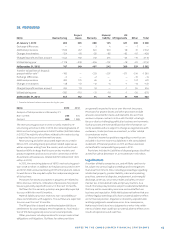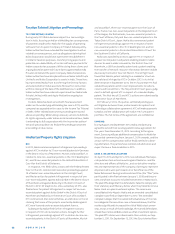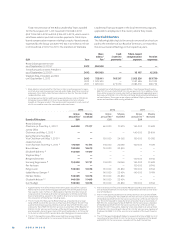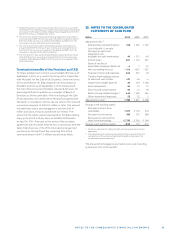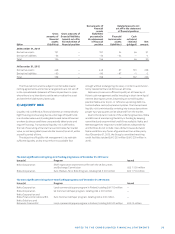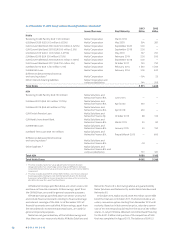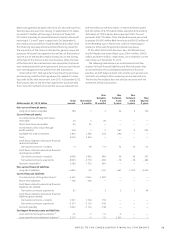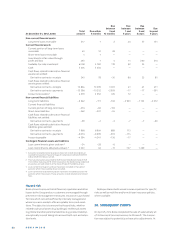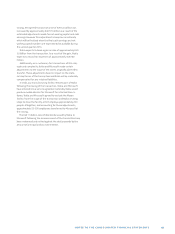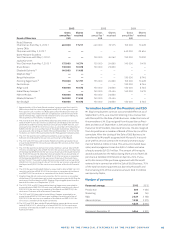Nokia 2013 Annual Report Download - page 77
Download and view the complete annual report
Please find page 77 of the 2013 Nokia annual report below. You can navigate through the pages in the report by either clicking on the pages listed below, or by using the keyword search tool below to find specific information within the annual report.
75
NOTES TO THE CONSOLIDATED FINANCIAL STATEMENTS
may, from time to time, have investments in public equity.
Such investments have not been included in the aforemen-
tioned number.
B) CREDIT RISK
Credit risk refers to the risk that a counterparty will default
on its contractual obligations resulting in fi nancial loss to the
Group. Credit risk arises from credit exposures to custom-
ers, including outstanding receivables, fi nancial guarantees
and committed transactions as well as fi nancial institutions,
including bank and cash, fi xed income and money-market
investments and derivative fi nancial instruments. Credit risk
is managed separately for business related and fi nancial credit
exposures.
Except as detailed in the following table, the maximum
exposure to credit risk is limited to the book value of the
fi nancial assets as included in the consolidated statement of
fi nancial positions:
‘
EURm 2013 2012
Financial guarantees given on behalf of
customers and other third parties 12 12
Loan commitments given but not used 25 34
37 46
Business related credit risk
The Company aims to ensure the highest possible quality in
accounts receivable and loans due from customers and other
third parties. Nokia and NSN Credit Policies, both approved by
the respective Leadership Teams, lay out the framework for
the management of the business related credit risks in Nokia
and NSN.
Nokia and NSN Credit Policies provide that credit decisions
are based on credit evaluation including credit rating for larger
exposures. Nokia and NSN Rating Policy defi nes the rating prin-
ciples. Ratings of material exposures are approved by Nokia’s
Rating Committee and NSN’s Rating Committee. Credit risks
are approved and monitored according to the credit policy of
each business entity. When appropriate, credit risks are miti-
gated with the use of approved instruments, such as letters of
credit, collateral or insurance and sale of selected receivables.
Credit exposure is measured as the total of accounts receiv-
able and loans outstanding due from customers and commit-
ted credits.
The accounts receivable do not include any major concen-
trations of credit risk by customer. The top three customers
account for approximately .%, .% and .% (.%, .%
and .% in ) of Group accounts receivable and loans due
from customers and other third parties as at December ,
, while the top three credit exposures by country amount-
ed to .%, .% and .% (.%, .% and .% in ),
respectively with China being the biggest exposure.
The Group has provided allowances for doubtful accounts as
needed on accounts receivable and loans due from customers
and other third parties not past due, based on the analysis of
debtors’ credit quality and credit history. The Group estab-
lishes allowances for doubtful accounts that represent an
estimate of incurred losses as of the end of reporting period.
All receivables and loans due from customers are considered
on an individual basis in establishing the allowances for doubt-
ful accounts.
As at December , , the carrying amount before
deducting any allowances for doubtful accounts as well as
amounts expected to be uncollectible for acquired receivables
relating to customers for which an allowance was provided or
an uncollectible amount has been identifi ed amounted to EUR
million (EUR million in ). The amount of allow-
ance recognized against that portion of these receivables
considered to be impaired as well as the amount expected to
be uncollectible for acquired receivables was a total of EUR
million (EUR million in ) (see also Note and Note ).
These aforementioned sums are relative to total net accounts
receivable and loans due from customers of EUR in
(EUR million in ).
An amount of EUR million (EUR million in )
relates to past due receivables from customers for which no
allowances for doubtful accounts were recognized. The aging
of these receivables is as follows:
EURm 2013 2012
Past due 1 – 30 days 53 250
Past due 31 – 180 days 43 70
More than 180 days 13 45
109 365
Financial credit risk
Financial instruments contain an element of risk resulting from
changes in market price of such instruments due to counter-
parties becoming less credit worthy or risk of loss due to coun-
terparties being unable to meet their obligations. This risk is
measured and monitored centrally by Treasury departments in
Nokia and NSN. Financial credit risk is managed actively by lim-
iting counterparties to a suffi cient number of major banks and
fi nancial institutions and monitoring the credit worthiness and
exposure sizes continuously as well as through entering into
netting arrangements (which gives Nokia the right to off set in
the event that the counterparty would not be able to fulfi ll the
obligations) with all major counterparties and collateral agree-
ments (which require counterparties to post collateral against
derivative receivables) with certain counterparties.
Nokia’s investment decisions are based on strict creditwor-
thiness and maturity criteria as defi ned in Treasury related
policies and procedures. As a result of this investment policy
approach and active management of outstanding investment
exposures, Nokia has not been subject to any material credit
losses in its fi nancial investments in the years presented.
The table below presents the breakdown of the outstanding
fi xed income and money market investments by sector and
credit rating grades ranked as per Moody’s rating categories.


